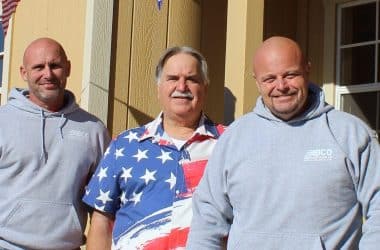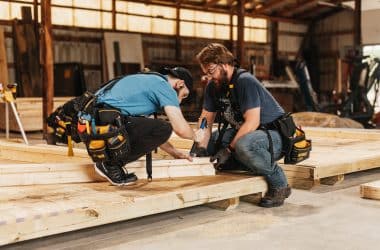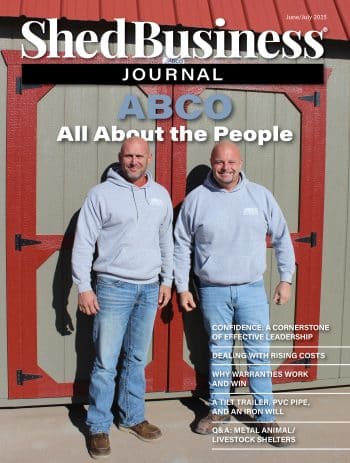
When Kris Zimmerman started 5-Star Buildings, based in Cuba, Missouri, in 2012, he was a subcontractor for another business where he learned the ins and outs of shed building, hauling, and selling.
From those experiences, his own character, and his faith in God, he crafted a mission statement by which the business operates: Providing high-quality, well priced sheds with appealing designs.
Today, Zimmerman is partners with his father-in-law Delbert Petersheim, who handles sales, and Gene Fox, who runs the hauling side of the business.
And every employee is dedicated to upholding 5-Star’s mission.
Shed Business Journal spent some time at the 5-Star shop, chatting with Zimmerman, Fox, and Petersheim about the business, its customers, and its operation.
How did you each get into the shed industry?
ZIMMERMAN: Shortly after I got married at 21, I just thought I’d try this opportunity that was hauling sheds.
There was a guy in our church and there was noise that the current hauler was going to leave. There was a need there, and it was just kind of a wing-it type of thing.
I bought a new Power Stroke ’06 and a basic old trailer with the only option was tilt and a winch roller trailer. Three-tab shingles and tarps. I look back now and I’m like, how did we even get sheds anywhere?
Then it was just a progression. The first shed trailer I bought was a slightly used Pine Hill Trailer from about 2009. From there, I eventually found a used Mule 3. We’ve been through Mule 3, 4, 5, and 7. We’ve kind of done the whole thing.
It was a small company, so I quickly got into talking with dealers and helping find lots and working in the shops some. I was at that for probably five years.
And then we moved into this area and that same company was good with me starting a sub shop with the painted lines and the treated lines.
That’s what we did here in 2012. We started as a subcontractor initially, and then in 2015, I bought that side of the business, the painted line. Then at that point, it was totally its own company. I guess that’s all I know what to do is sheds.
FOX: I started in 2021. I’m real green to the shed industry. We were living in north Missouri, looking to move down here and for a small group to meet with for church stuff. I was running an auto body shop up there. I’d been in automotive from 15 to 35.
I was at that point in my life wondering am I going to do auto body all my life or something else and Kris said, how about hauling?
I wasn’t sure about this shed thing. I knew nothing about construction. Like, I couldn’t even build my own doghouse.
So, I came down and rode along with Kris one day sometime in mid-2020. It was a cluster. We were out late at night in the rain moving a shed, railroad ties, it was the whole bit. It was a junk shed that we moved. It got dark. It was raining.
My biggest concern was I like to be challenged. If it doesn’t have a challenge, I’m going to get bored. I’m like, this will offer the challenge. I think I can give this a try.
I was thinking about my personal health being in paint fumes and paint all the time and hoping to live longer than 50 and not have a bunch of health issues. That’s kind of what got me into it.
I got my CDL license a couple of months after we moved here in 2020 and spent that first part of 2021 riding with Kris learning the ropes of how to set a shed.
I do most of our maintenance. I’m fairly mechanically inclined.
I’ve helped back there in the winter when hauling was slow, played gopher, but as far as building goes, I have very limited skills.
ZIMMERMAN: We have some unique pieces that Gene’s very much a part of designing and building and welding.
I have found a lot of space to develop different things inside the industry. It’s not like we’ve just been a shed builder, a shed hauler, and that’s all we’ve done.
We’ve been able to work with marketing, get our hands in the online stuff a little bit, and there’s always a chance to invent something new. I like new ideas.
PETERSHEIM: I grew up on a dairy farm and at 15 started working on a pole barn crew. That was sort of facing real life, going from a pampered dairy farm to pole barns.
I ended up in construction when I was 23 or 24. I was in residential construction and did a lot of homes, remodeling.
I really enjoyed carpentry, but making ends meet back through those years in the ’90s was tough. So, we moved up here, and I was sort of burned out on running crews.
I told Kris if he gets an opening, I wouldn’t mind coming on. That’s sort of how it started. We moved in 2011 and started in 2012.
Sales is my primary job. I do a bit of the outside work as far as lawn, try to keep the outside looking good. And some of the specialty trim.
You mentioned marketing. Talk about that a little. How are you getting customers to find your sheds?
ZIMMERMAN: I would say the foundation is simply being here for 12 years and always having tried to produce a good shed, a high-quality shed. That term feels worn out in the shed industry, and we see a lot of junk out there.
FOX: I think customer referrals are a huge piece of what we have going on. I hear over and over again, my neighbor bought it. My neighbor referred, had a good experience. My aunt or my uncle or grandfather had a great experience, and they said go try these guys, go look at their stuff.
ZIMMERMAN: I would say that’s our biggest draw, and that only comes from a long time, slowly getting this reputation.
We’re a little bit, in some ways, behind the times on our whole media, and we’re actually not that interested in too much social stuff right now.
A big part of our sales is right in Cuba here and the surrounding areas. It’s a fairly small town, but we got a pretty good location here.
I think the location along with the time and a good experience and leading to the referrals, I really think that at this point is our main thing. That has kind of eliminated the need for right away jumping online and everything, but we have been feeling over the past 4-5 years that we really need to have that side covered as well.
So that’s where we got on with E-Impact. They totally rebuilt our website, and we keep working that way, designing our brochures and banners we hand out.
We have a CRM that’s hooked to the website. We’re just at a place of fully integrating that and taking more advantage of that.
Our website, I think it’s fair for how easy it is to find, and we keep putting a bit of money in just keeping it current, up-to-date and powerful. But it’s more like we need to be able to be found organically well, and people when they get there, they find what they’re looking for. To help achieve this, we’re using IdeaRoom’s 3-D Builder.
FOX: One of the things that we’ve done I think is a little bit unique is recently we purchased some land in a neighboring town (Rolla) and just put static displays in there. That’s worked out really well.
We’re just using it as a tool to get product out there for people to see and driving them back to the main office within areas where we struggled with sales. It’s only 25 miles away and we were selling less than a dozen sheds a year. We worked with online stuff on it and couldn’t seem to really boost our sales.
That lot, it was within less than a month that we started getting regular requests and regular sales going into that area.
We try to follow up on how customers find us. What was your method that got you here? And overwhelmingly it’s been we’ve seen them driving up 72. It exceeded expectations.
ZIMMERMAN: A little bit of noise I’ve heard from people is static lots are a thing of the past. I don’t believe that.
There are people, at least in our customer base, that, yes, they can find us online—I think the online needs to back up what they find—but there’s something about actually seeing a physical building repeatedly as you’re on a road that you regularly travel.
We’re available. We’re real.
How have you gotten to know your customer base here in Cuba?
FOX: Kris is very detailed-oriented and very quality-oriented, and what I’ve seen is our demographic is primarily that 45-and-up group of people who are very hands-on.
They’re concerned with more than what the Internet says, but what do I see when I go look at this product?
I would say our demographic kind of came out of Kris’s attention to detail and concern for quality that keeps going in that people group kind of gravitated this direction more than 5-Star reaching out and saying what is the demographic that we can target.
Tell us a little bit about the sales process with customers.
ZIMMERMAN: Almost all our sales are face-to-face. We do a few through email where they’ll mail in a check. In a lot of ways, we’re kind of old school, and we’re not really apologetic about that. It seems to work well.
We get the expectation levels at the right place, and we get some of that invaluable relationship going on that you won’t get with an online-only transaction. So, when Gene goes to deliver the shed, they’re talking about Delbert who they met at the sale, and we have a good base to work out differences or print adjustments.
Currently, we have three locations. In some ways, we’ve been shrinking the amount of dealers we have and doing a lot out of this location. We’re just not interested in too many small dealers.
FOX: Delbert does a really good job on that first point of contact for company image and relationship stuff. I continuously get comments on their interactions with Delbert, who does an extremely good job of being personable and meeting the people’s needs.
PETERSHEIM: I enjoy sales. It seems like getting behind the face of people is interesting to me, and so often in today’s world, people are lonely and ready to talk.
I’m open to talk about buildings right off as the opportunity opens up, but I ask them what they do for a living and try to get into their life a little bit.
It’s interesting where people go with that. That’s what I enjoy.
How does the build process work in the shop?
ZIMMERMAN: We used to all work on the same shed, one at a time.
Once we moved up here, it was all individual workstation-oriented. Everybody was start-to-finish on the building, and it didn’t get moved until it was done. We dabbled in on-sites, pouring concrete—we’ve changed a lot of stuff from when I first started.
Beginning in ’23, we switched everything over to an assembly line. It’s a little different than most assembly lines. We actually move them sideways instead of long ways.

The floor gets built toward the middle of the shop while the walls are built on a framing table that we put together. Then, we’re using a couple of jib cranes to set the walls.
After the walls are all up and nailed, then it moves sideways for the next one to start. Then it gets trusses and roof sheeting and painting and then it can get moved over for doors and trim and hardware, more painting.
The big ones usually only move once. It’s as compact as it could be and still be workable.
We have four full-time employees in the shop and then two part-time.
FOX: Everybody involved has got in mind that we’re aiming for quality at the end. The whole way through, everybody’s paying attention.
For example, I’m lifting it on the trailer, and I noticed that periodically we’re getting nails missing in the floor joists. There’s a direct line back where I can go to the shop manager and say this has happened a time or two. Let’s be more careful with our nails. There’s a clear path to fix the minor things quite quickly.
Most buildings don’t sit here a week after being built. There’s a direct connection between me seeing the bottom of it walking around the building, paying attention to what’s going on, and being able to relate that back. There’s not a three-week gap between problems occurring to fixing the problem.
ZIMMERMAN: He’s not just a delivery driver. He’s part of the company, and he’s part of this whole process. We’ve tried to be intentional about connecting all the pieces together.
How do you find the people who deliver that quality? How do you train that into them?
ZIMMERMAN: I think that kind of stuff just comes with long-term thinking. I say there’s been a lot of God’s blessings happening because you know, in the end, we’re not smart enough to make it all just click.
We’re not just hiring people fast and putting them into management. There’s a bit of thought, and that limits your growth.
You can only grow as fast as you can feel good about how fast your systems, culture, and everything are growing. Do we have what it takes?
We’re trying to live healthy, balanced lives, not just work around the clock.
FOX: Sheds are not our life.
I think, too, like Mark (Mast) having been here so long, he knows what Kris’s expectation is for a building to look like. He knows what Kris’s vision for quality is, so some of it is growing into him. Some of it is who he is as a human being.
ZIMMERMAN: The two newer guys who started a year ago, they were shown what to do.
We try to have a small meeting on Monday morning, just who’s here this week, who needs to take off? What’s the list of buildings coming up? If Gene’s seen an issue or something, he can send me a picture. I can show images of quality issues.
We just try and keep up a connectedness to everything. That’s hard. It takes a lot of work to connect things.
FOX: And we’re committed to not having growth that exceeds what a decent lifestyle can have or that harms quality.
At the end of the day, our feeling is if we can’t put out a quality product, we’re not doing our customers a service. It’s not just about the money that’s left at the end of the year.
We want the customer to have a building in 10 years that they can look at and still say this was a good purchase and we don’t regret this purchase. Anything that begins to hinder the quality of our product, we try to sniff that out as quick as possible and work against it.
From whether it’s advising the customer on what type of ground, what to do, and prepping for their shed, clear through the whole process, trying to see that they have the best long-term experience possible.
ZIMMERMAN: We’re not out to just drop off the shed, collect the check, and move on. We do want that referral. We do want that solid customer base that in the end really likes what happened.
FOX: It’s much better to go out of our way and spend two hours with the customer who did have an issue, or something didn’t go as they expected and to spend that time and hear them out and try to remedy the problem. Caring the whole way through is something that’s valued.
ZIMMERMAN: We’re talking here of where we want to be and what we try to do, not like “we nailed this.”
FOX: We have failures at times. We mess up with customers and look back and say I really screwed up that situation in an epic way. But it’s really rare to experience that.
Part of it is the process. When the order comes in and Kris gets your order, again it’s attention to detail. He looks that order over carefully, and somebody orders a shed that’s green and red with a white roof on it. Kris makes a phone call and says are you really sure this is what you want to do? Maybe there’s a better a better way to go.
We’ve had people change colors and later say, I’m so glad Kris talked me into changing that color because it wouldn’t have been right, and I would have regretted that color.
ZIMMERMAN: One thing we’ve done, I think, that’s helped our customer base is we don’t offer long rent-to-own plans and the lowest entry sign-up costs. It puts seriousness about getting a shed from us. It’s trust going both ways.
We’re a small company building 300 sheds a year, max, at this point.We’ve just tried to care about things. We want sustainable systems, sustainable structures, sustainable growth. We wouldn’t mind growing a little more as we can with feeling like our structure management is keeping up well. Efficiency is important to us with material, time, design, and the shop.




